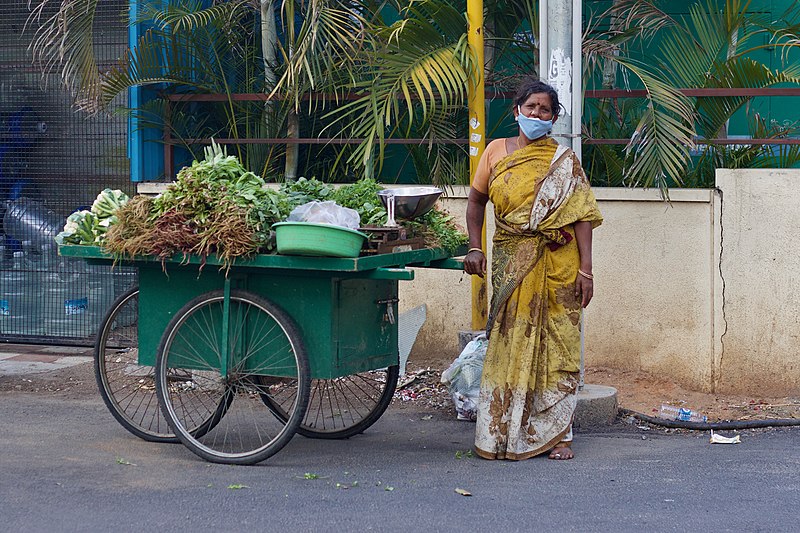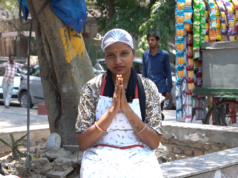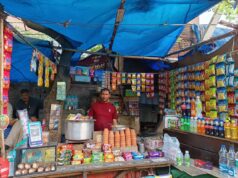Without the luxury of working from home, street vendors and hawkers, who could often be seen selling on the street corners, footpaths and local markets, have been struggling to survive. While the first wave hit them hard, there was a glimmer of hope towards the end of last year with lockdown restrictions easing up. However, the second wave has brought with it a myriad of setbacks, the persisting fear of infection being overshadowed by the threat to their livelihood.
The Period Force Labour Survey from 2017-18 shows that street vendors account for 4.2% of total urban employment in India and for over 14% of India’s urban informal economy. Metropolitan cities host the highest concentrations of street vendors, with close to 3,00,000 street vendors in Delhi and 2,50,000 in Mumbai. Despite forming such a critical part of India’s informal economy, with a daily turnover of Rs 80 crores, the profession received legal recognition only in 2014.
The Street Vendors (Protection of Livelihood and Regulation of Street Vending) Act, 2014 intends to regulate street vendors in public areas and protect their rights, providing for Town Vending Committees (TVCs) to be set up in each city.
TVCs are responsible for carrying out surveys of street vendors, issuing vending certificates and drawing lots to ensure that the holding capacity of zones is maintained. TVCs have been working in most cities with varying degrees of success. While Delhi boasts of over 28 TVCs, which some claim has diluted the implementation of the Act, Chandigarh’s TVC has been lying defunct for the last 4 months. To date, the Act has been unsuccessful in providing improved work conditions for street vendors, protecting them against arbitrary and exploitative law enforcement practices and using urban spaces to generate employment opportunities for the poor. In an effort to balance the interests of urban planning and mobility with the welfare of street vendors, the policy has empowered law enforcement to essentially clamp down on vending.
Threats and harassment from municipal and law enforcement authorities and illegal evictions from their vending spots were made worse by the pandemic and lockdown. Consumer preference for online retailers, hygiene issues and unplanned lockdowns have created a ripple effect on the earning capacity of millions of street vendors. The government’s solution to this was a micro-credit relief package in the form of PM Street Vendor’s Atma Nirbhar Nidhi or SVANidhi. Touted by the government to be the first urban livelihood programme for street vendors in Indian history, the scheme provides vendors with a working capital loan of up to Rs. 10,000, which is repayable in monthly instalments in the tenure of one year. The web portal and app have been designed to administer the scheme with an end-to-end solution. The Ministry of Housing and Urban Affairs claims that 23.24 lakh loans had been sanctioned and 18.54 lakh loans had been disbursed to the beneficiaries by March 2021.
Centre for Civil Society organised several community conversations with women street vendors from Delhi and Rajasthan to understand the challenges they faced during the lockdown and their experiences with the micro-credit scheme. While some vendors were not aware of the process to be followed for availing the loan, most vendors had at some point tried to apply. The app-based application process, with the objective of promoting paperless digital access to micro-credit facilities, has also proven to be a deterrent for vendors lacking the technological resources or prowess to navigate through the portal. One woman shared that her loan applications were rejected without providing any reasoning. Moreover, the benefits of the scheme are only extended to street vendors profiled by the government, which essentially links it to registration requirements. When only 131000 out of 300000 street vendors are in possession of registration proof in Delhi, the scheme is bound to exclude many.
However, the most widely cited grievance among the street vendors was perhaps the requirement of paying back the loan within a year. Given the deep impact of the pandemic and the subsequent lockdowns, street vendors have had to dip into their savings to survive. In the last one year, with markets and transportation either shut down or heavily restricted, their earnings have fallen drastically. In this situation when street vendors are struggling to feed themselves and their families, availing a loan under the SVANidhi scheme has pushed many further into the debt trap. Some women shared that they had to borrow from local moneylenders at exorbitant rates to be able to pay back the loan on time, while others have already defaulted on payments.
Given the unintended consequences arising out of a micro-credit scheme like SVANidhi, the government should consider converting it into an AADHAR-linked direct cash transfer scheme, to be implemented through local Town Vending Committees. The advantage of this approach would be threefold: credit constraints would be eased, street vendors would be able to choose whether to use the cash towards setting up a business or saving and every vendor with an Aadhar account would be able to avail the benefits. Conversations with street vendors make it clear that alleviating their pandemic-induced distress will take a lot more than the current policy. Encouraged by cash benefits provided to e-rickshaw drivers and construction workers by the Delhi government, street vendor associations have been demanding similar support from their local governments. States like Karnataka, Odisha and Madhya Pradesh among others, have successfully transferred funds to accounts of street vendors.
Street vending was illegal in urban India for almost six decades and even though it was legally recognised in 2014, vendors are still not considered entrepreneurs or business owners. The impact of the pandemic has been particularly severe since the nature of work, which requires excessive mobility and access to consumers, goods and markets, precludes the luxury of work-from-home. Street vendors, who have been a part of India’s urban life for centuries, have played a critical part as the last link in the supply chain, ensuring essentials like groceries, vegetables and fruits were available throughout the pandemic at the risk of their own health. It is surprising that government schemes like SVANidhi have done very little to improve the ease of doing business for these frontline workers.
Read more: It makes sense to export, not scrap old cars
Post Disclaimer
The opinions expressed in this essay are those of the authors. They do not purport to reflect the opinions or views of CCS.






